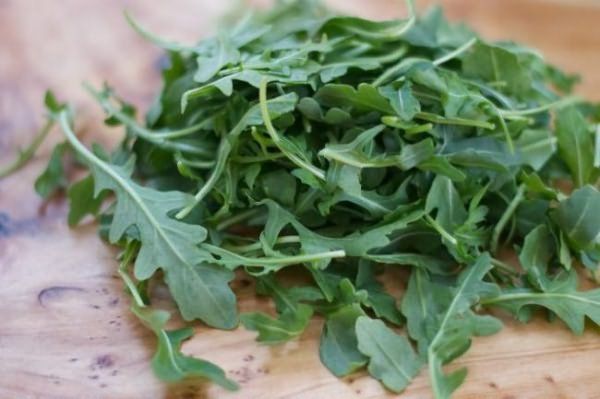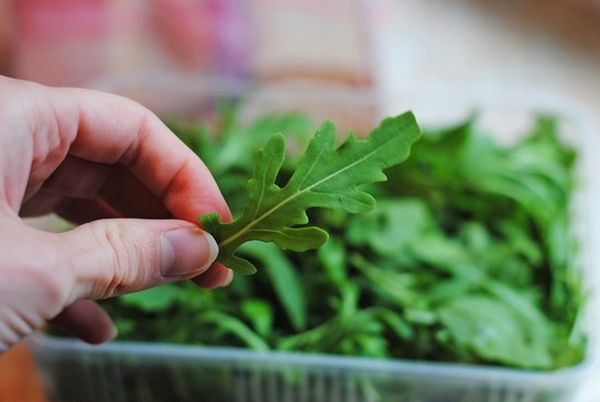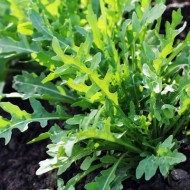What is arugula and how to use it in home cooking and cosmetology
Content
A brief description of arugula
Arugula (Italian Rucola) belongs to the Cabbage family, known as caterpillar or eruka. Many people mistakenly assume Italy is the birthplace of the annual plant due to the prevalence of the ingredient in Italian cuisine. However, the plant came to the vastness of Europe from North Africa.

Arugula grows in small bushes up to 60 cm high, and looks like a salad. Straight stems are covered with long leaves with carved wavy edges, collected at the base into a rosette. From May to July, the plant is covered with small light yellow flowers with purple veins, which form cluster-like inflorescences. With the arrival of summer, eruka begins to bear fruit in elongated pods with brown seeds located inside.
Only young grass, which has a specific aroma and spicy-sour taste, is used in salads. But for the preparation of mustard or oil, seeds are used.
Video "Why is arugula useful and what is made from it"
In this video, you will learn how arugula is useful and what dishes can be prepared from it.
Common varieties
Thanks to breeders, many varieties of arugula have been bred. All of them are usually classified according to two criteria: the timing of maturation and the period of ontogenesis.
Victoria
Eruka early ripening (25 days). Leaves are oval, elongated, collected in a lush rosette. Arugula has dietary properties, is rich in vitamins, and has a pronounced nutty flavor. The maximum height of the bush is 20 cm.
Dikovina
Mid-season variety, ripening 1 month after sowing. Dikovina grows no higher than 20 cm. Shoots are dark green, lyre-like. Young greens with spicy taste go well with meat or fish dishes.
Olivette
The ripening time is only 3 weeks. The height of the Olivette ranges from 15 to 20 cm. The leaves are long, slightly rounded, bright green in color. The young herb is distinguished by its nut-mustard aroma and mild bitterness, for which it is highly valued in cooking.
Solitaire
Arugula of medium ripening (35–40 days). Shoots are thin, long, carved. Growing up, they form a rosette up to 18 cm high. Solitaire has a rich taste and aroma, contains many vitamins, minerals, and also carotene.
Poker
Refers to early maturing varieties that ripen 20 days after sowing the seeds. Poker is distinguished by large elongated shoots of rich green color with carved edges. The plant grows up to 20 cm. The young grass tastes bittersweet with nutty notes.
Rocket
Eruka early ripening (23 days).Straight stems up to 20 cm long are covered with thin long dark green leaves with carved edges. A low-calorie herb with a mustard flavor will complement meat, fish or seafood dishes.
Spartacus
The first greens from the bushes of arugula Spartak are cut off as early as 19 days after sowing the seeds. Elongated shoots with rounded carved edges form lush rosettes with a height of 18 to 20 cm. Differs in a soft, piquant taste, used for preparing salads.
Arrows of Cupid
The most popular medium-ripening variety. You can eat young greens only 35-40 days after sowing. The maximum plant grows up to 30 cm. Shoots are thin, long, with carved edges.
Chemical composition and nutritional value
Arugula is a low-calorie food. 100 g of grass contains only 25 kcal. The nutritional value of eruki is:
- 2.6 g of proteins;
- 0.7 g fat;
- 2 g carbohydrates;
- 91.7 g of water.
The plant is a rich source of essential oils, including mustard and fatty oils. It also has a useful chemical composition:
- vitamins (B, A, C, E, K);
- micro-, macroelements (Na, P, Ka, Mg, C, Zn, Cu, Mn, Fe, Se);
- flavonoids;
- organic acids.
Useful and medicinal properties of the plant
Due to the high content of nutrients, eruka has a positive effect on the human body. A large list of benefits includes:
- prevention of oncological diseases;
- antiseptic properties;
- help in the fight against dermatological problems;
- increased immunity;
- antiviral action;
- rejuvenation of the body;
- maintaining tone;
- normalization of the digestive tract;
- strengthening the central nervous system;
- lowering cholesterol levels;
- increased hemoglobin;
- beneficial effect on the organs of the reproductive system;
- restoration of water-salt balance.
The essential oils in arugula make it a powerful aphrodisiac.

Application in home cosmetology
In addition to being used in cooking, eruka is often used in home cosmetology. The products made from this plant are rich in nutrients necessary to maintain the health of the skin of the face and scalp. For example, with their help you can get rid of dandruff, strengthen hair follicles, revive curls, and give them a natural shine. Often masks are prepared from arugula that help:
- whiten the skin, make it firm and elastic;
- eliminate rosacea;
- get rid of puffiness;
- prevent the occurrence of neoplasms;
- moisturize the skin of the face;
- heal damage;
- slow down the aging process and the appearance of wrinkles.
From wrinkles
To prepare the anti-wrinkle remedy, cut half a banana with a blender, the same amount of cucumber and 40 g of arugula. A homogeneous mass is evenly applied to the face. The mask is kept for half an hour, and then washed off with water at a comfortable temperature.
From the vascular network
The recipe for a cosmetic product for rosacea includes 60 g of eruka, 3 tbsp. l. potato juice, 1 tbsp. l. milk cream. The crushed herb is mixed with the rest of the ingredients and applied to the skin of the face, excluding the area around the eyes. The procedure takes 25-30 minutes. To achieve a greater effect, it is recommended to first rinse the mask with warm water, and then rinse your face with cold water.
For skin firmness
To prepare the mask, you will need 1 egg, 1 tsp. olive oil, 60 g arugula. The protein separated from the yolk is combined with the rest of the components and mixed well. The mass is applied in two layers, waiting until the previous one dries. The product is kept for half an hour and then washed off.
For moisturizing and whitening skin
A cucumber mask will help get rid of age spots, lighten the skin tone, and moisturize it. Grate cucumber and zucchini on a fine grater, mix 3 tbsp each. l.each vegetable mass with 60 g of chopped eruka, then applied to the face. The procedure takes 25 minutes.
When peeling
If the skin is prone to dryness and flaking, use an aloe-based product. 1 tsp the pulp is mixed with 1 tsp. lemon juice and 60 g of arugula. Leave the evenly applied mass for 30 minutes. After a while, wash off with cool water.
Dandruff
The mask will help not only get rid of dandruff, but also stop hair loss. For its preparation, you will need 20 g of warmed honey, 60 g of eruki oil, 10 g of hot red pepper. The ingredients are mixed until smooth and rubbed into the hair roots. The product is left on for 30 minutes and then washed off with shampoo.
To strengthen hair follicles
To prepare a mask to strengthen hair follicles, mix 2 tbsp. l. two oils - arugula and almonds. Massage the product into the scalp and leave for 60 minutes. After the expiration of time, the hair is thoroughly washed with shampoo under warm water.

For a healthy shine to dry and loose curls
You can revive dull curls with a simple nourishing mask consisting of 4 components: 20 g sesame oil, 40 g eruki oil, 1 tsp. warm honey, 1 yolk. The ingredients are whipped until smooth and distributed through the hair from roots to ends. The mask is kept for an hour.
Cooking applications
Arugula is indispensable in Italian and Mediterranean cuisine. They like to serve it on its own or as a side dish. Young greens are an excellent addition to meat, fish, seafood and beans. It enhances the flavor of some cheeses and is often combined with spinach or salad. Culinary experts love to cook various sauces from eruka, add it to vegetables. Sometimes the herb is even used to make desserts.
It is customary to tear arugula with your hands or put it whole in a dish. In contact with the knife, an oxidation process takes place, which kills most of the beneficial properties of the plant.
How to choose the right one
Greens suitable for food should be bright green, rich in color, without yellow spots. It is better to choose young leaves of small or medium size, as they have less bitterness and astringency. The fresher the eruka, the more nutrients it contains. Dishes made with arugula should be eaten immediately after serving, until the herb has lost its spicy aroma.
Healthy and delicious recipes
Spicy eruka can make any dish unique and original. Below we will look at simple recipes for salads made from this herb:
Arugula vegetable salad with shrimps
For cooking you will need:
- 75 g of hard cheese;
- 120 g of boiled and frozen shrimp;
- 225 g of young greens;
- 1 tbsp. l. olive oil;
- 1 tbsp. l. soy sauce;
- 3 tsp lemon juice;
- 1 tsp liquid honey;
- 150 g cherry tomatoes;
- 1 clove of garlic;
- salt to taste.
The shrimp are scalded with boiling water and the shell is carefully removed. Chopped garlic cloves are fried in olive oil until golden brown. Then it is taken out, and peeled shrimps are laid in its place. Fry them on both sides for 1 minute. For dressing, mix lemon juice, honey, soy sauce, add some salt to taste. Eruki leaves are spread on a dish, shrimps and cut tomatoes are poured on top. Season the salad with sauce, sprinkle with cheese, mix.

Arugula salad with mozzarella
Required Ingredients:
- 4 cherry tomatoes;
- 225 g mozzarella;
- 5 g of young greens;
- 3 tsp apple cider vinegar;
- 3 tbsp. l. olive oil;
- salt and pepper to taste.
Cherry tomatoes and mozzarella are cut into slices of the same thickness. Spread alternately in layers on a dish, alternating with eruki leaves. The salad is dressed with a sauce of olive oil, apple cider vinegar, salt and pepper.
Arugula and beans salad
The recipe provides for:
- 400 g canned red beans;
- 300 g of young greens;
- 2 bell peppers;
- 300 g feta cheese;
- 2 cloves of garlic;
- 100 g sour cream (you can take homemade mayonnaise or natural yogurt);
- salt and pepper to taste.
Cut the pepper and feta cheese into small cubes. Mix in a salad bowl with washed beans, chopped eruka, garlic. Salt and pepper to taste. Before serving, season the dish with one of the selected sauces.
Storage rules and secrets
Arugula is stored in the refrigerator, avoiding proximity to products that release ethylene. If you put grass next to such fruits or vegetables, it will wither quickly. Plucked young greens retain their properties for 4 days. To extend this period, you can place the bundle in water. For longer storage, you can use the freezer.

Possible harm and contraindications
In moderation, eruku can be eaten by almost everyone. People with individual intolerance should be careful. It is also not recommended to use arugula for patients with pathologies of the liver, kidneys, urinary tract. During pregnancy and lactation, it is better to remove young herbs from the diet or consult a doctor.
Arugula is a real storehouse of nutrients. It is not for nothing that nutritionists and people who promote a healthy lifestyle love her so much. To make the herb available at any time of the year, you can grow it on your windowsill.



